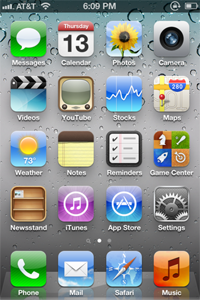
Back آي أو إس 5 Arabic IPhone OS 5 Catalan IOS 5 German IOS 5 Greek IOS 5 Spanish آیاواس ۵ Persian IOS 5 French IOS 5 HE IOS 5 Hungarian IOS 5 Italian
| Version of the iOS operating system | |
 | |
 iOS 5 home screen running on an iPhone 4 | |
| Developer | Apple Inc. |
|---|---|
| Source model | Closed, with open source components |
| Initial release | October 12, 2011 |
| Latest release | 5.1.1 / May 25, 2012 |
| Update method | Software Update |
| Package manager | App Store |
| Platforms | |
| Kernel type | Hybrid (XNU) |
| License | Proprietary EULA except for open-source components |
| Preceded by | iOS 4 |
| Succeeded by | iOS 6 |
| Official website | Apple - iOS 5 - 200+ new features for iPad, iPhone, and iPod Touch. at the Wayback Machine (archived September 10, 2012) |
| Tagline | We've taken iOS to a whole new level. |
| Support status | |
| Obsolete, unsupported[citation needed] | |
iOS 5 is the fifth major release of the iOS mobile operating system developed by Apple Inc., being the successor to iOS 4. It was announced at the company's Worldwide Developers Conference on June 6, 2011, and was released on October 12, 2011. It was succeeded by iOS 6 on September 19, 2012.[1]
iOS 5 revamped notifications, adding temporary banners that appear at the top of the screen and introducing the Notification Center, a central location for all recent notifications. iOS 5 also added iCloud, Apple's cloud storage service for synchronization of content and data across iCloud-enabled devices, and iMessage, Apple's instant messaging service. For the first time, software updates could be installed wirelessly, without requiring a computer and iTunes. iOS 5 also featured deep integration with Twitter, introduced multitasking gestures on iPads, and added an easily accessible camera shortcut from the lock screen.
iOS 5 was the subject of criticism for iPhone 4s users, as the initial release had poor battery life, failures of SIM cards, and echoes during phone calls. These problems were fixed in subsequent releases.
iOS 5 is the last version of iOS that supports the third-generation iPod Touch and first-generation iPad.
- ^ Tam, Donna (September 12, 2012). "Apple's iOS 6 release date: Start your downloads on Sept. 19". CNET. CBS Interactive. Archived from the original on May 14, 2021. Retrieved June 14, 2017.